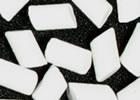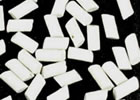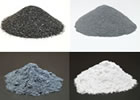Petrified Wood - Rock Tumbler Rough
Make interesting tumbled stones from fossil wood
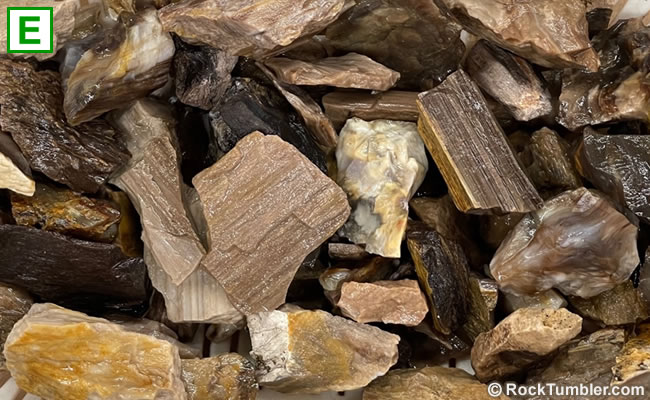
This photo shows some of our North Dakota petrified wood tumbling rough - sized for use in a small rotary tumbler. The rough in the photo above is wet to show full color. Pieces range in size between 3/8" and 1 1/2".
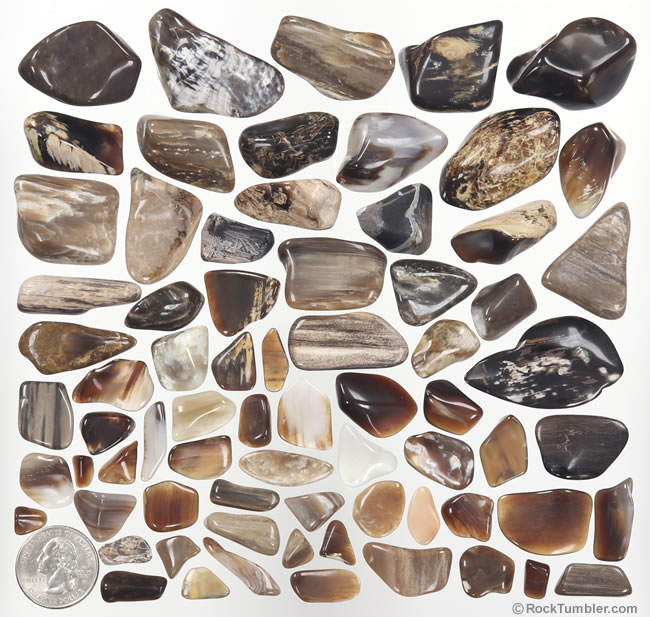
The photo above shows some pieces of our North Dakota petrified wood tumbling rough after tumbling and polishing using the recipe described below. Thin, translucent-to-transparent pieces show the nicest wood grain.
Petrified Wood - Silicified Fossil Wood
 ,
,  , and
, and  What do they mean?
What do they mean?
Size:
SMALL PIECES - mostly 3/8 to 1 1/2 inches - for small tumblersThis item is a two-pound bag of petrified wood from North Dakota localities. It is mostly in shades of brown, gray and white. In the rough state, many of these pieces of fossilized wood display visible wood grain that becomes more visible (and usually more interesting) when they are polished.
This petrified wood has been crushed to small pieces with a particle size of approximately 3/8" (9 mm) to 1 1/2" (38 mm) in diameter - just the right size for a small rock tumbler. The small, thin pieces are usually the ones that will exhibit the best wood grain after polishing. The wood is silicified, and that gives it a hardness similar to quartz, jasper, and agates. Shown above is a photo of this material after we polished it.
We always use TXP polish - an aluminum oxide compound - for polishing this material. It does a great job and is inexpensive.
We have tumbled a lot of this wood, and some of the tumbled stones look like modern wood that has been tossed on the beach. Some pieces have a translucent character that enables you to see veils of wood pattern within the material. It's always a surprise to examine the polished material! Thin translucent pieces often show the most interesting wood grain.
EASY Rock Tumbling Recipe:
Petrified Wood (3/8 to 1 1/2 inches)
The small petrified wood above has been crushed and sized to perform well in small rotary tumblers such as the Thumler's MP-1, A-R1, and A-R2. The size range gives the material a good tumbling action and eliminates the need for ceramic media. Our EASY Rock Tumbling Recipe works well for rough that has a Mohs hardness of 7 and has been crushed to a variety of particle sizes under about 1 1/2 inches.
Recipe for Rotary Tumbling
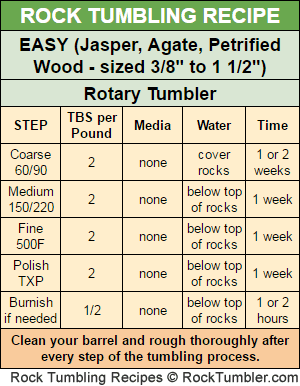
Coarse Grit Step:
Fill your tumbler barrel about 2/3 full of rough. Then add 2 tablespoons of coarse (60/90) grit per pound of material in the barrel. Add water to just below the top of the rocks. Run the material in coarse grit for 1-2 weeks. One week in coarse grit will give you good results. However, we always open the barrel, dump out the rough, rinse it thoroughly, return it to the tumbler barrel, add fresh grit, and tumble it for a second week. That extra week in coarse will produce nicer stones with fewer blemishes and better shapes.
At the end of all steps in the rock tumbling process, make sure to clean your rocks, tumbler barrel and lid thoroughly to reduce the chance of coarser grit contaminating the finer grit steps. Do not allow the muddy water to go down a drain.
Medium Grit Step:
Put your cleaned rough back into the barrel. Then add 2 tablespoons of medium (150/220) grit per pound of material in the barrel. Add water until it is just below the top of the rocks. Let it tumble for one week.
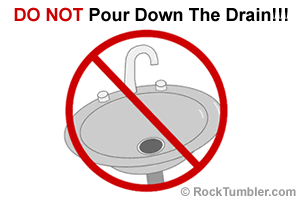
Barrel slurry dumped down the drain will harden like concrete.
After clean-up, put the rocks back into the barrel using 2 tablespoons of fine grit per pound of material. Again add water to just a little below the top of the rocks. Tumble for one week. The rocks should now be smooth and possibly starting to get a slight luster.
Polish Step:
IMPORTANT: Make sure that your barrel and rough have been cleaned thoroughly. Any grit carried over from a previous step will likely ruin your polish. Place the rough in the barrel with two tablespoons of TXP polish for each pound of material in the barrel. Add enough water to almost cover the rocks and let it tumble for one week.
Burnish If Needed:
Jasper, agate, and petrified wood usually take a great polish. However, burnishing this material after the polish step can often improve the shininess of the finished stones. If you would like to try burnishing to see if it improves the look of your polished stones, full burnishing instructions can be found here.
Customers also bought...
Large Ceramic Media

Small Ceramic Media

Standard Grit Kit



